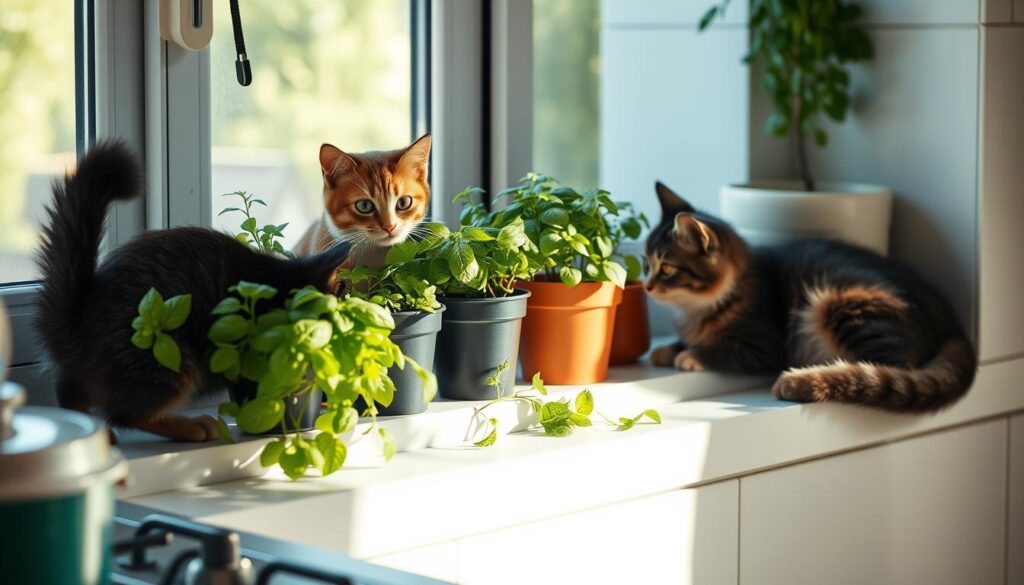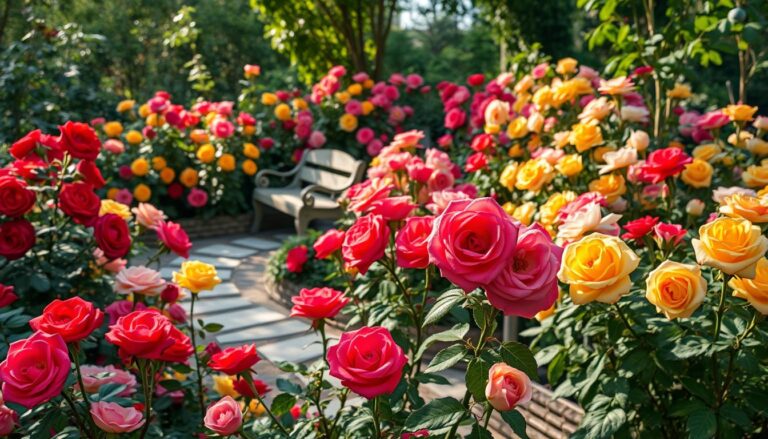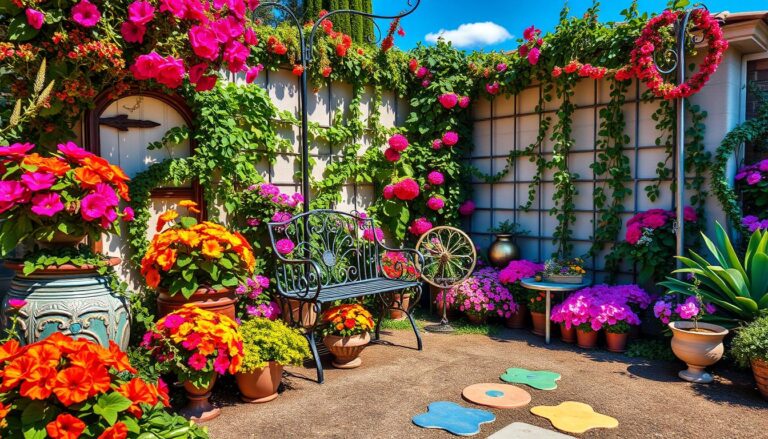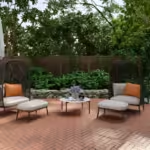As a cat owner, you want to give your feline friend a fun and engaging space. A cat-friendly indoor herb garden is a great idea. It’s also a way to add fresh herbs to your cooking. Growing herbs indoors with cats is easier than you might think.
Imagine having a 24-inch long and 6-inch wide indoor herb garden. It has 14-inch high legs and can grow 6 types of herbs like Lemon Balm and Purple Basil. You can use 1 1/4″ brad nails to fasten the sides and add silicone sealant to keep water in. This makes a beautiful and functional garden that your cat will love.
Creating a cat-friendly indoor herb garden gives your cat a natural space to explore. You can learn to grow herbs indoors with cats and save money. In this article, we’ll show you how to make a cat-friendly indoor herb garden. We’ll also give tips on choosing the right herbs and keeping your cat safe.
Benefits of an Indoor Herb Garden for Cat Owners
Creating a cat-safe indoor herb garden is rewarding for both you and your cat. It lets you enjoy fresh herbs all year while giving your cat a natural space. This setup is beautiful and saves money because it needs little space and care.
One big plus of an indoor herb garden is keeping herbs safe from your cat. By putting herbs in a safe spot, you stop your cat from eating toxic plants. Here are some ways to keep herbs out of your cat’s reach:
- Place the herb garden at least 3 feet above ground level to reduce accessibility.
- Use deterrents like sticky tape or pet repellent around the plants.
- Provide cat grass as a safe alternative to deter harmful plant nibbling.
By using these tips, you can enjoy many benefits from a cat-safe indoor herb garden. It’s a great way to add fresh herbs to your cooking and give your cat a fun, natural place to play.
| Benefit | Description |
|---|---|
| Fresh Herbs | Year-round access to fresh, healthy herbs for cooking. |
| Natural Space | A stimulating environment for your cat to explore and play. |
| Cost-Effective | Minimal space and maintenance required, reducing costs. |
Choosing the Right Location for Your Herb Garden
When setting up a cat-proof indoor herb garden, picking the right spot is key. You need a place that gets enough sunlight and is safe for your cat to explore.
Most herbs need 4-6 hours of direct sunlight each day. Look for a spot near a window that gets lots of natural light. This will help your herbs grow well and make a cozy spot for your cat.
- Easy access for upkeep, so you can water and trim without bothering your cat.
- A stable and secure area, where your cat can’t knock over the plants or pots.
- A spot with good air flow, to stop moisture from building up and harming your herbs.
By picking the right spot for your herb garden, you can make a space that thrives and is safe for your cat. It’s a place where you and your cat can both enjoy.
Best Cat-Friendly Herbs to Grow Indoors
Creating a cat-friendly indoor herb garden means picking safe and fun herbs for your cat. You can grow catnip, basil, and chamomile indoors. These are great for both your garden and your cat. Here are some cat-friendly herbs to start with.
Some popular cat-friendly herbs include:
- Catnip: a feline favorite that can provide your cat with hours of entertainment and stimulation
- Basil: a popular herb among cats that can be used in a variety of dishes
- Chamomile: a safe and soothing herb that can help calm your cat and promote relaxation
When growing an indoor herb garden and cats, it’s crucial to ensure the herbs you choose are non-toxic to your feline friend. By selecting cat-friendly herbs, you can create a safe and enjoyable environment for your cat to explore and play. With a little planning and care, you can have a thriving indoor herb garden that brings joy to both you and your cat, and learn how to grow herbs indoors with cats.
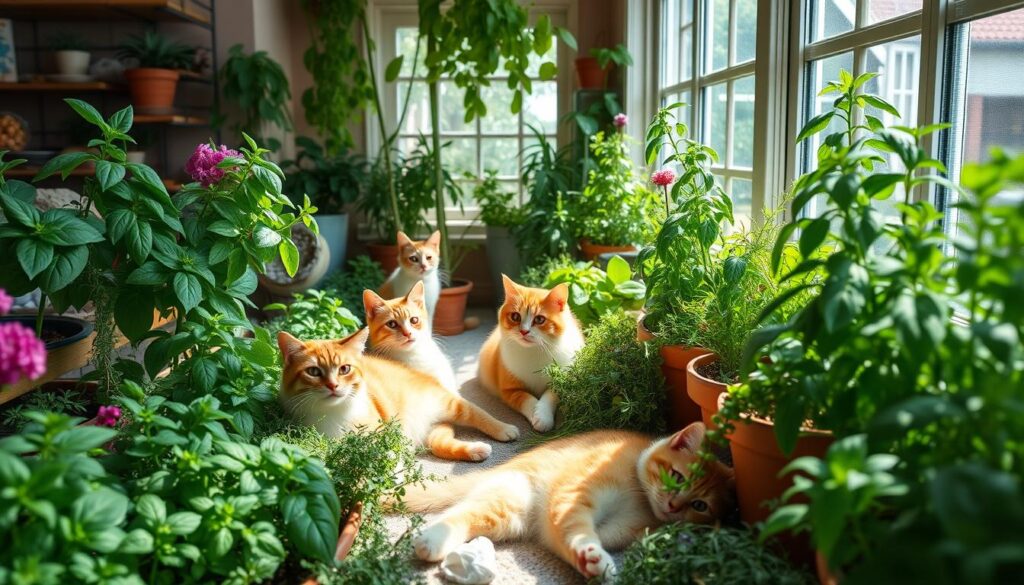
| Herb | Safe for Cats | Benefits |
|---|---|---|
| Catnip | Yes | Provides entertainment and stimulation |
| Basil | Yes | Can be used in cooking and promotes relaxation |
| Chamomile | Yes | Helps calm and soothe cats |
Common Herbs to Avoid for Cats
Creating a cat-safe indoor herb garden is key. Some herbs are toxic to cats and must be kept away. Place herbs in a secure spot and use barriers to block access.
Herbs like lilies and philodendron are toxic to cats. Garlic and chives can harm a cat’s red blood cells. Watch for signs of toxicity, such as vomiting, diarrhea, and lethargy.
Stick to safe herbs like thyme, sage, and parsley. These are non-toxic and can freshen up your garden. Follow these tips to keep your cat safe while enjoying your garden.
Other herbs to avoid include:
- Lemongrass
- Mint
- Oregano
- Tarragon
These can cause vomiting and diarrhea in cats. Keep them out of reach. By knowing which herbs to avoid, you can create a safe garden for you and your cat.
Essential Supplies You’ll Need
Creating an indoor herb garden for cat owners requires the right supplies. You’ll need the right pots and soils, and organic gardening methods for safety. Choose pots that are 6-8 inches deep for your herbs’ root growth.
Some great herbs for indoor gardens with cats are catnip, basil, and chamomile. These herbs are safe for cats and can be grown indoors. Look for organic soils without chemicals or toxins.
Choosing the Right Pots and Soils
For an indoor herb garden, pick pots that drain well and have good air. Terracotta or ceramic pots are good because they breathe and prevent soggy soil.
Organic Gardening Methods for Safety
Organic gardening is key for a safe indoor herb garden for cat owners. Use natural fertilizers like compost or manure tea. Avoid chemical pesticides and herbicides.
Tools to Help with Indoor Gardening
Essential tools for indoor gardening include a watering can, pruning shears, and fertilizer. Use a self-watering pot or a moisture meter to water your herbs right.
With the right supplies and organic gardening, you can have a thriving indoor herb garden. Choose safe herbs for your cat and take care to keep them safe.
| Herb | Toxicity | Care Requirements |
|---|---|---|
| Catnip | Non-toxic | Well-draining soil, indirect sunlight |
| Basil | Non-toxic | Well-draining soil, direct sunlight |
| Chamomile | Non-toxic | Well-draining soil, indirect sunlight |
Creating a Designated Cat Space
To make a cat-proof indoor herb garden, give your cat a special area. This spot should be safe and comfy for them. It also needs to protect your herbs from damage.
Think about adding cat shelves and elevated planters. These can be a cozy spot for your cat to rest and play. They also keep your herbs safe from your cat’s curiosity.
Cat Shelves and Elevated Planters
Cat shelves and elevated planters are great for a cat space. Place them near a window for sunlight and views. This keeps your cat away from your herbs.
Using Cat Grass to Deter Herb Damage
Use cat grass to keep your cat away from herbs. Cat grass is safe for cats to eat. It can distract them from your herbs. Plant it in a pot and put it in your cat’s area.
By setting up a cat space and using cat grass, you can make a safe herb garden. Choose herbs that are safe for your cat. Also, keep toxic plants out of your cat’s reach.
- Choose herbs that are safe for your cat to be around
- Keep toxic plants out of reach
- Provide your cat with a designated space to rest, play, and explore
Care Tips for Keeping Your Herbs Healthy
To keep your indoor herb garden and cats happy together, follow some key care steps. This includes setting up a watering schedule, fertilizing your cat-friendly indoor herb garden, and regularly pruning and harvesting your herbs.
Here are some important care tips to remember:
- Water your herbs when the soil feels dry to the touch. Avoid over-watering, as it can harm their health.
- Fertilize your herbs often to help them grow well and prevent pests.
- Prune and harvest your herbs to encourage new growth and prevent them from becoming too long.
By following these tips, you can create a vibrant indoor herb garden and cats can enjoy together. Always check the specific needs of each herb to give them the best care.
How to Involve Your Cats in the Gardening Process
Creating a cat-safe indoor herb garden is a great way to get your cats involved in gardening. It provides a safe and fun space for them to explore and play. You can teach them to respect the garden by using tips for keeping herbs away from cats, like placing herbs out of reach or using barriers.
Some cat-friendly herbs for your garden are basil, chamomile, and valerian. These herbs are safe for cats and make a great environment for them. You can also give them cat grass or wheatgrass. These are full of nutrients and help keep your cats healthy.
Here are some benefits of involving your cats in gardening:
- Encourages exploration and play
- Provides a stimulating environment
- Helps to teach cats to respect the herb garden
- Supports overall health and well-being
By following these tips and creating a cat-safe indoor herb garden, you can make gardening fun for your cats. Always watch them when they’re in the garden. Make sure they have fresh water and a balanced diet.
| Herb | Benefits | Precautions |
|---|---|---|
| Basil | Rich in antioxidants, supports dental health | None |
| Chamomile | Soothes skin irritations, calms upset stomachs | None |
| Valerian | Promotes activity and playfulness, supports relaxation | Use in moderation |
Troubleshooting Common Gardening Issues
When you care for your indoor herb garden, you might face some common problems. These include pests that could attract cats, herbs that grow too big, and diseases. It’s key to watch your herbs closely and act early to stop these issues.
Herbs like catnip and basil, which are good for indoor gardens with cats, can get pests like aphids and whiteflies. These pests might draw cats, so it’s important to spot and fix them fast. Use natural methods, like neem oil or insecticidal soap, to keep pests away.
To handle overgrown herbs, trim them often to keep them in shape and healthy. This also stops cats from getting caught in long stems or leaves. For diseases, check your herbs for signs like yellow leaves or black spots. Use organic fungicides if you see any.
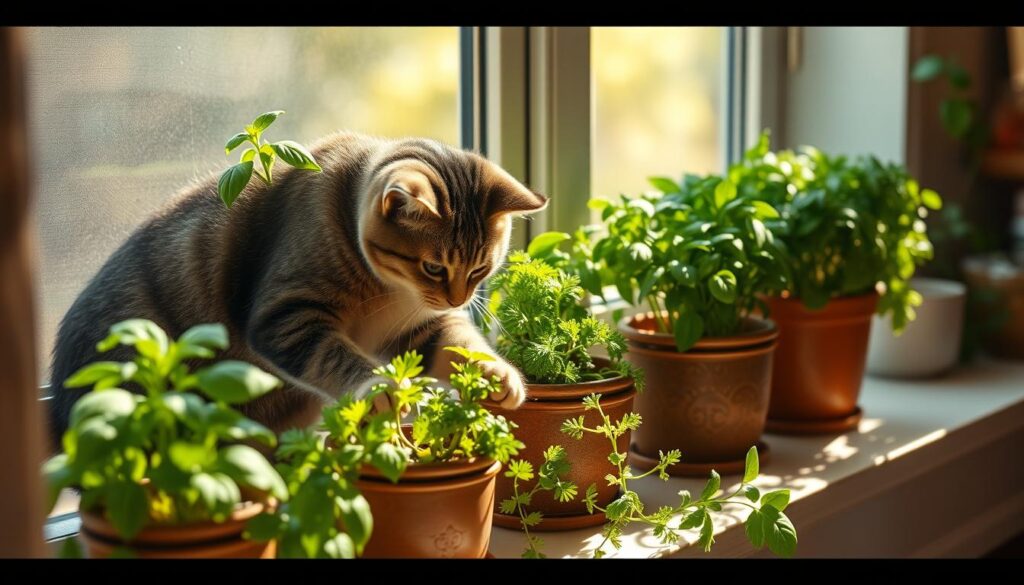
- Use fans to improve air flow and stop fungal diseases
- Make sure your herbs get enough light to stay healthy and strong
- Water your herbs carefully to avoid too much water, which can cause root rot and other issues
By following these tips and staying alert to gardening problems, you can have a thriving indoor herb garden. You and your cats will love it.
Crafting a Cozy Herb Garden Atmosphere
To make a cat-friendly indoor herb garden cozy, start with comfy spots for your cats. Add soft cat beds or scratching posts near the herbs. This lets them relax and explore without harming the plants.
Choose decor for your cat-proof indoor herb garden that’s natural. Wood, stone, and woven textures fit well with your home’s look. They bring a calm feel. Make sure to add lots of natural light sources for the herbs to grow well. This also makes the space bright and airy, which cats love.
Combine comfy cat spots, natural decor, and sunlight to create a cozy herb garden. This way, you and your cats can enjoy a peaceful, inviting space. With some creativity, you can make a place that’s perfect for relaxation and fun.
FAQ
What are the benefits of an indoor herb garden for cat owners?
An indoor herb garden offers many perks for cat owners. It brings fresh herbs into your home. It also gives cats a natural place to explore. Plus, it’s a cost-effective way to garden.
How do I choose the right location for my indoor herb garden with cats?
Pick a spot that gets enough sunlight for your herbs. Make sure it’s safe for your cat to play. And choose a place that’s easy to reach for upkeep.
What are the best cat-friendly herbs to grow indoors?
Catnip, basil, and chamomile are great for indoor gardens with cats. They’re safe and fun for your feline friend.
What common herbs should I avoid for my indoor herb garden with cats?
Stay away from lilies and philodendron. They’re toxic to cats. Watch for signs of herb poisoning like vomiting, diarrhea, and tiredness.
What supplies do I need to create a thriving indoor herb garden with cats?
You’ll need the right pots and soil for your herbs. Also, get a watering can, pruning shears, and organic fertilizer.
How can I create a designated cat space in my indoor herb garden?
Use cat shelves and elevated planters for a cat area. Adding cat grass can also help keep herbs safe.
What are some tips for properly caring for my indoor herb garden with cats?
Keep a watering schedule and use the right fertilizer. Regularly prune and harvest your herbs to keep them healthy.
How can I involve my cats in the gardening process?
Give your cats safe places to play and explore. Teach them to respect the garden.
What are some common gardening issues I might face with an indoor herb garden and cats?
Pests, overgrown herbs, and diseases are common problems. Watch your herbs closely and use organic methods to prevent and fix these issues.
How can I create a cozy and inviting atmosphere in my indoor herb garden for my cats?
Add cozy spots for your cats. Choose natural decor and use natural light. This will make your garden warm and welcoming.

